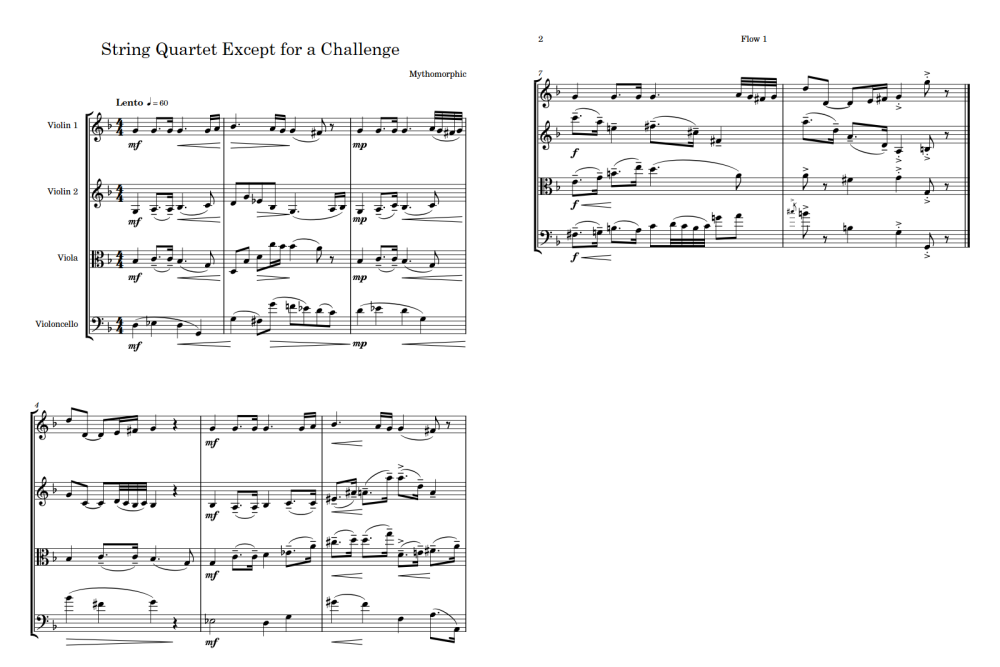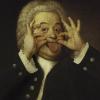Leaderboard
Popular Content
Showing content with the highest reputation on 06/29/2025 in Posts
-
"Lion Heart," was written to describe the 12 Day War that is happening. I came up with my own system of modulating serialism: Home | Music Set Modulator The modulations work very well, giving the atonal music a sense of perspective and direction. The twelve day war opens with a trumpet fanfare, in response the upper woodwinds copy what the trumpets had said. After the initial statement, the music modulates to another tonal center. While the set modulates, it is not a direct transposition. Modulation is dynamic. The whole song is very percussive, like a machine gun bursts in some areas, bombs dropping in other areas, intermittent with lyrical rational between the instruments. Just when you think the twelve day war is over, a final percussive drive is offered. The form is closer to rondo, though the piece is sectioned symmetrically with an adagio section in the middle, according to the piano score. Much changes were made in the wind ensemble arrangement, which I will have a score soon. LionHeart.mid1 point
-
Hi to everyone. This week I've been working on an exercise to orchestrate Debussy's Prelude No.6 from Book 1. I came up with two versions, one with a very restricted instrumentation, and the other with a larger ensemble. Interested to know which you think works best? The final bass dyad was very problematic, due to its extreme low pitch. It sounded too intrusive and twangy in the harp, and seemed off-pitch in the double-bass, with a horrible grating timbre. Eventually I decided to remove the lowest note altogether in the version with restricted instrumentation, and have the upper note pizz. instead of arco.1 point
-
A Piece of Me, for You.pdf A Piece of Me.mp3 Despite the simplicity, I think this one turned out absolutely awesome. it was inspired by some... for lack of better words... interestingly put together scoring done by a novice user on the Musescore platform. The only thing that is anywhere near the same is the feel I thought he was goin for, and the key of Ab Major being used, with emphasis on the Major 7ths. (Which I love so so so much. Me and Major 7th chords talk with one another often... hehe) Hope you all enjoy. Let me know what you think! IF anybody wanted to pick up the piece to play it, please please please feel free to do so, I just want a recording of it 😅 😅 😅1 point
-
Hey Peter my boy! Since you have listed out your really detailed review in point form, I should reply by point form too! 1. That is called RUBATO man!!😜 2. That's what I love in Beethoven's music too haha! I think the muddy texture is what caused the next passage to be "confused" when your mind goes muddy! 3. I love it too! That same falling fourth motive is from the beginning of the whole sonata! I think I learn this kind of German sixth progressions from Brahms. 4. I love that too, I think I am inspired by b.108 in the 1st movement when I did the same there! 5. Well not only here, but also in point 11 I only have a 1-bar transition to another passage. I would say I want these two abrupt transitions to show how confused I was at that time, but maybe they did sound too abrupt. Though I liked the effect, as if I didn't I won't retain them haha! 6. It IS difficult to play, the fingerings there are very weird to play with, but for my beloved C# minor I HAVE NO CHOICE haha. 7. Yeah that Locrian inflection here and also in the blues section comes exactly from the opening of the second movement! 8. I like that too, as I find it a bit difficult to transit reasonably with the change of style! 9. Haha yeah that melody is from the falling fourth motive of the 1st movement. This passage is hard to play with in order to emphasize that falling fourth motive in between the crazy dotted rhythms. 10. Yup the juxtaposition shows how conflicted I was then. That question like phrase is more questioning myself as I always do in my whole life lol. 11. That sweet melody comes from nowhere lol, though it's combined with the first theme of the 2nd movement at the very coda in counterpoint. That theme was born when I was having a walk. Initially I doubted whether I should introduce a new theme in the development of a final movement of a Sonata, but I just couldn't discard it given how beautiful that was, so I just retained it. 12. Yeah I don't like having the right hand playing the melody all the time haha, especially after my chamber music training. 13. Haha yeah I understand, because that passage sounds unrelated to any existing material of the whole Sonata. Though that is the passage which gave me confidence back in composing and by composing that I knew I could write good music again. It's devilish hard to play as well! 14. Yup I was more conflicted there too so I introduced the juxtaposition of material AND tempo too. Just like the ending of the 1st mov of Bee's op.130. 15. It's not from the Sextet, but rather from the second movement of this Sonata with the pentatonicism. I even quote that theme here too! 16. Yup I was conflicted whether to end the piece in a more peaceful way or tragic way, but this is my answer as I couldn't lie to myself and forced a fake Picardy 3rd ending as in many Romantic Sonatas. Thx for your review! Henry1 point
-
Hey @Mooravioli! I never mind you taking long for replying, given that you finally do reply haha! Truly appreciate it! Thx for your repeated listenings! Yup you said all I thought in the piece. Well you are right to observe that the random pauses interrupt the flow, because that's my intention. For me the blues are just escape lands of Utopia that needed to be interrupted by the real reality particularly in the recap section when I was already more awakened than in the exposition! I realized it was futile to escape imaginarily. Haha I actually love the bluesian Fx! Thx! Yeah all the anguish and pain worths after I finish my Sextet, it's a once-in-lifetime to have completed it in this perfect (I think) way. Thank you! Henry1 point
-
Hi @Alex Weidmann! Love your orchestration especially that contrabassoon. I think adding con sordino for the strings will make another timbre for the quiet sound. Thx for sharing! Henry1 point
-
Sometimes between writing my more complex and difficult to write music, I write something that is easy. This is one of those pieces, and I just felt like sharing.1 point
-
Hi everyone! This is my first piece for full symphony orchestra, first post, (and my first "completed" composition: a lot of firsts), and I'm definitely still learning how to orchestrate better, create nicer textures, and pace my compositions/develop melodies (all for fun, I just like listening to music and playing a little bit haha, so I don't have any formal composition background). This piece was inspired by various Romantic composers (with quotes from my 3 favorite symphonies--one is really obvious but I'm interested to see if others will recognize the snippets I tried to include) and includes two central themes. I'm open to all the advice I can get! Thanks for your time! PS. my score is really chaotic and I still need to clean up all the accidentals and stuff.1 point
-
Yes, the intent was to be more static in the creation. As recently I’ve been trying to work on my form and trying to be careful with ensuring that the melodic / harmonic voices are distinct from one another, as I have been told in previous pieces that I tend to blur the line between them at times. plus, I believe that soft/heartfelt pieces express much of their beauty within their simplicity. “Less is more” is how I see it with this sort of theme. Allowing the sound of the instruments to breathe in the air for a moment, and giving the room a chance to carry sound, in my opinion, impacts an audience better than if there was fluently complex chord structures, and limited breaks between phrases. 🙂 PS id also like to point out that this sort of theme is quite different from my typical stylistic choices when it comes to composing. So was really dipping my toes in the water with this one. I’m usually writing in a more “Adagio” or “Andante” style, rather than “Grave” or “Larghetto”1 point
-
This is quite good for a first attempt at orchestral writing! I definitely hear allusions to other composers' works (Mahler, Dvorak, and Sibelius come to mind...with a hint of Bruckner). I do take issue with the title of the piece. When I think "Rhapsody", I expect something a little more virtuosic...doesn't have to be "fast", but needs more ornamentation and something show-off-y. I would call this maybe an "Orchestral Fantasy" due to its episodic form. Orchestration is a little odd for winds. You can probably reduce the flute section to just 2 + piccolo. You can also probably reduce to 4 horns. Strange there are no trumpets or additional trombones. The scoring is a bit haphazard and confusing as you can't tell which wind part is suppose to play when (unless they are constantly doubled?) Also, I've never seen a horn part using the tenor clef (and for some reason its only in Horns 5/6).1 point
-
1 point
-
Hello @L.S Barros, The piece does sound very English for me with all those colorful Picardy 3rds. I don't know if I mishear but I think I catch a parallel 5th in 0:31, maybe it's the organ sound. Thx for sharing. Henry1 point
-
I really like how it turned out. Both the sounds you used (the organ in particular, or whatever it is) and the composition itself.1 point
-
Hello @L.S Barros and welcome to the forum! Nice sonata! I assume (you can correct me if I'm wrong) that this is a sonata de camera? I love the constant exchange between major and minor mode that is so characteristic of music in this style, with all its Picardy 3rds (as I learned on your server). I do wonder how it would sound if you tried reversing the pattern - like, what if a phrase in a major mode ended on a minor chord? Or maybe you or some other Baroque-style composer already do this? I get the sense that this is a dance and is a piece that could easily be danced to in real life rather than just being a dance form that evolved out of an actual dance but is meant to be just an instrumental (which is why I'm guessing that this is a sonata de camera). Thanks for sharing and I hope you find this forum to be a good platform to share more of your works and participate by listening to other composers' works and possibly reviewing them! Kind regards,1 point
-
Hi y'all, second post on this forum... Here's a piece I finished a while back. Hope you like it!1 point










.thumb.png.8b5b433a341551e913a34392660bc95b.png)